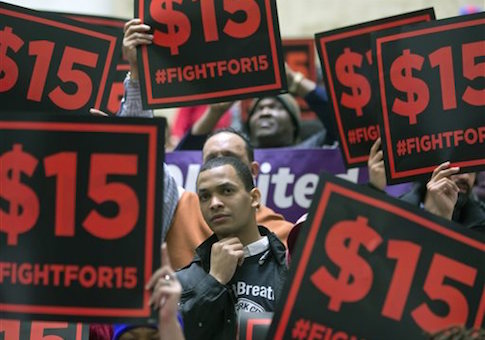One of the nation’s most politically powerful unions spent about $20 million agitating for the $15 minimum wage in industries it hopes to unionize, according to a new report.
The Center for Union Facts, a labor watchdog, analyzed federal labor filings from Service Employees International Union and found that the union contributed millions of dollars to front groups organizing local and state protests outside of fast food restaurants.
The union contributed more than $16 million to workers organizing committees in 2015. Those committees are typically established as nonprofits and are not subject to the stringent labor laws that bar unions from staging continuous strikes. They have staged dozens of walkouts and demonstrations at local restaurants over the past several years.
"The $20 million figure is likely much higher, as it excludes some staff salaries, expenses paid for legal services, as well as money paid to minimum wage advocacy groups such as the National Employment Law Project (NELP) and the Economic Policy Institute (EcPI)," the group said in a release.
The union has also shelled out millions to public relations firms and pro-labor think tanks, which have churned out friendly press coverage for the astroturf demonstrations and provided intellectual ammunition in legislative battles.
Liberal PR giant Berlin Rosen collected nearly $2 million from union coffers. The Economic Policy Institute and National Employee Law Project have authored many pro-minimum-wage-hike position papers and studies contradicting the consensus among economists that steep minimum wage hikes lead to job losses and higher prices, received more than $300,000.
Richard Berman, executive director of the Center for Union Facts, said that this spending is a misuse of dues money taken out of worker paychecks. Members, he said in a release, do not benefit from public demonstrations involving non-members workers, such as fast food employees.
"While the SEIU has made some headway in its push for a job-killing $15 minimum wage, working Americans appear to be sending a clear message to SEIU big spenders: ‘Find a way to create jobs rather than diminishing them,’" Berman said.
The SEIU did not respond to request for comment.
The SEIU’s campaign has found success in states dominated by Democrats. A New York wage board convened by Gov. Andrew Cuomo hiked wages for fast food restaurants to $15 after a series of contentious hearings in 2015.
The SEIU and other labor activists put a measure that would have approved a $15 wage on the November ballot in California to pressure Gov. Jerry Brown (D.), who had expressed skepticism about the rate.
After successfully gathering more than 400,000 petition signatures for the ballot initiative, Brown and state lawmakers struck a backroom deal to hike the wage to $15 by 2022, but negotiated flexibility concessions that allow the state to delay the implementation based on economic conditions.
"The $15 campaign may generate some legislative wins, but even former SEIU boss Andy Stern has acknowledged that this big-spending strategy isn't sustainable," Berman said.
Michael Saltsman, a labor expert at the pro-free market Employment Policies Institute, said that political success has come at the expense of the union’s members. The union has lost more than 30,000 members over the past five years.
"After more than three years of fighting for $15, the SEIU has a handful of policy victories to show for it—but not much else. Spending tens of millions of dollars on a quixotic campaign while losing members is not a growth strategy, and the rank-and-file are right to be displeased that their paychecks are funding pricey PR campaigns," Saltsman said.
